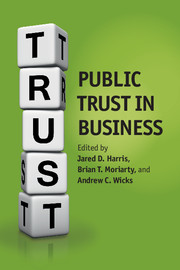Book contents
- Frontmatter
- Contents
- List of figures
- List of tables
- Notes on contributors
- Preface: discovering new territory in public trust in business
- Acknowledgments
- 1 Public trust in business: what’s the problem and why does it matter?
- Part I Trusting the institution of business
- 2 The economic crisis of 2008, trust in government, and generalized trust
- 3 Too big to trust? Managing stakeholder trust in business in the post-bail-out economy
- 4 At the crossroads of trust and distrust: skepticism and ambivalence toward business
- 5 Public trust in business and its determinants
- 6 The role of public, relational, and organizational trust in economic affairs
- Part II Public trust and business organizations
- Index
- References
3 - Too big to trust? Managing stakeholder trust in business in the post-bail-out economy
Published online by Cambridge University Press: 05 July 2014
- Frontmatter
- Contents
- List of figures
- List of tables
- Notes on contributors
- Preface: discovering new territory in public trust in business
- Acknowledgments
- 1 Public trust in business: what’s the problem and why does it matter?
- Part I Trusting the institution of business
- 2 The economic crisis of 2008, trust in government, and generalized trust
- 3 Too big to trust? Managing stakeholder trust in business in the post-bail-out economy
- 4 At the crossroads of trust and distrust: skepticism and ambivalence toward business
- 5 Public trust in business and its determinants
- 6 The role of public, relational, and organizational trust in economic affairs
- Part II Public trust and business organizations
- Index
- References
Summary
EXECUTIVE SUMMARY
the situation
This chapter considers the aftermath of the financial crisis of 2008, and specifically the subsequent “bail-out” of the large financial institutions by the American government, from the perspective of trust in the post-bail-out economy. The author considers the impacts of both the compartmentalization of action within companies, and the increased complexity of interaction within business, on stakeholder trust in organizations.
key questions
To what extent does compartmentalization of action within companies inhibit trustworthy behavior on the part of organizations? To what extent does the complexity of interactions in business inhibit the ability of stakeholders to make accurate judgments of organizational trustworthiness? What is distrust in business and how is the nature of distrust evolving? Is stakeholder trust today more difficult to build and sustain than in response to previous crises?
new knowledge
Some of the operating assumptions made in most models of stakeholder trust may no longer hold. For example:
Relevant organizational actors, and associated behaviors, are no longer easily identified by the stakeholder.
The relevant trust dimension implicated in an organization’s behavior is no longer easy to identify.
Who an organizational decision will impact is no longer well understood.
The link between organizational action and organizational impact is no longer straightforward.
- Type
- Chapter
- Information
- Public Trust in Business , pp. 51 - 85Publisher: Cambridge University PressPrint publication year: 2014



